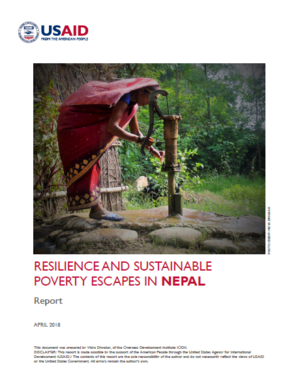Resilience and sustainable poverty escapes in Nepal
 Nepal experienced considerable poverty reduction over the last two decades. However, over the same period, several factors including low economic and agricultural growth, weak public infrastructure, continued exclusion of disadvantaged groups, and conflict and other shocks prevented households from escaping poverty, or pushed households which had escaped back into poverty. The focus of this report is on household poverty escapes and what explains the fact that some households escape and remain out of poverty (sustainable poverty escape or resilience), while other households escape poverty only to fall back into it (transitory poverty escape) and still others descend into poverty for the first time (impoverishment). This document combines analysis from three rounds of the panel component of NLSS with qualitative research approaches – in particular, key informant interviews, life histories and participatory wealth ranking – to further investigate the drivers of sustained and transitory poverty escapes and of impoverishment. The report investigates the resources (land, livestock and value of assets), attributes (household composition and education level) and activities (including jobs and engagement in non-farm activities) of households that enable them to build their resilience to sustainably escape poverty and minimise the likelihood of them falling back into poverty or descending into poverty for the first time.
Nepal experienced considerable poverty reduction over the last two decades. However, over the same period, several factors including low economic and agricultural growth, weak public infrastructure, continued exclusion of disadvantaged groups, and conflict and other shocks prevented households from escaping poverty, or pushed households which had escaped back into poverty. The focus of this report is on household poverty escapes and what explains the fact that some households escape and remain out of poverty (sustainable poverty escape or resilience), while other households escape poverty only to fall back into it (transitory poverty escape) and still others descend into poverty for the first time (impoverishment). This document combines analysis from three rounds of the panel component of NLSS with qualitative research approaches – in particular, key informant interviews, life histories and participatory wealth ranking – to further investigate the drivers of sustained and transitory poverty escapes and of impoverishment. The report investigates the resources (land, livestock and value of assets), attributes (household composition and education level) and activities (including jobs and engagement in non-farm activities) of households that enable them to build their resilience to sustainably escape poverty and minimise the likelihood of them falling back into poverty or descending into poverty for the first time.
